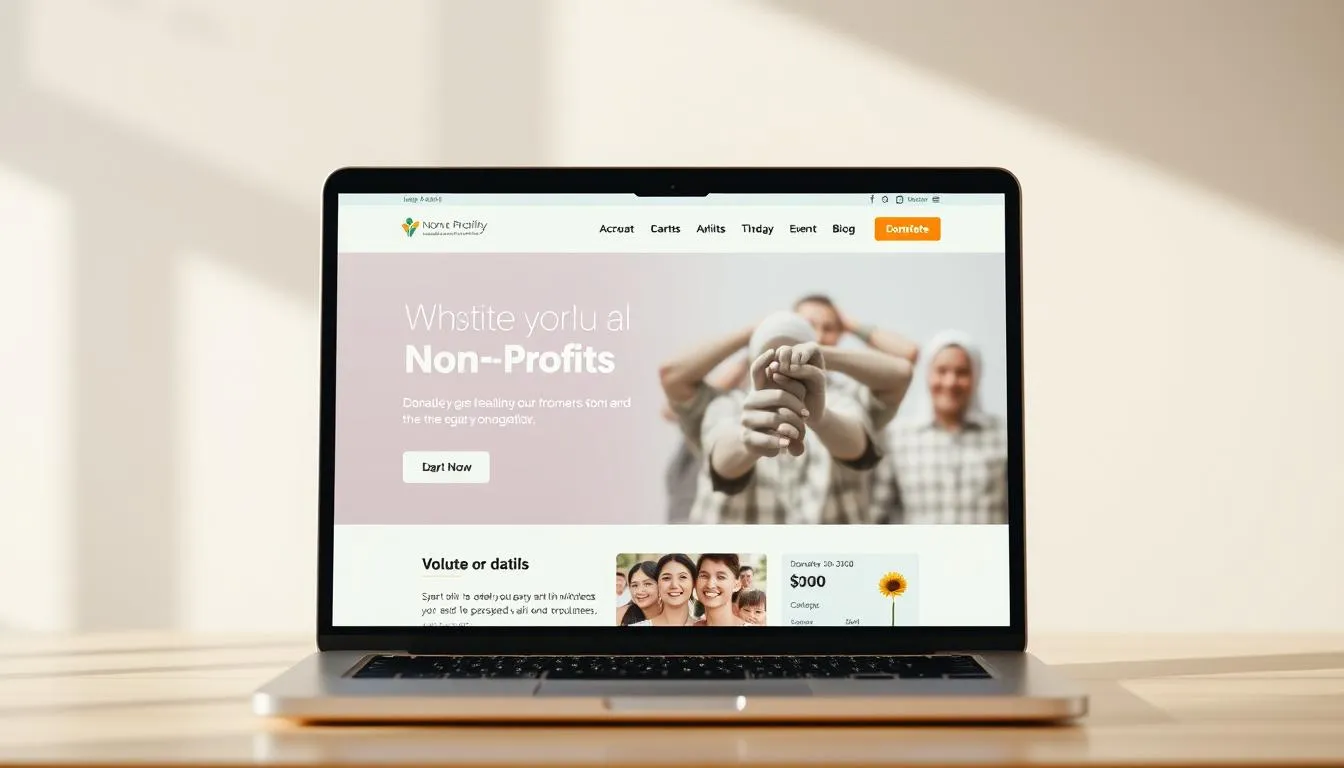Last Updated on: June 19, 2025
Creating a website for a non-profit organization is a crucial step in establishing an online presence and achieving its mission. A well-designed website can help charities effectively communicate with donors, volunteers, and the community.
Non-profit website design cost can vary widely depending on several factors, including the complexity of the design, the number of pages, and the technology used. Understanding these costs is essential for non-profits to budget effectively and make informed decisions about their online presence.
In this article, we will explore the various factors that influence website design for charities and provide a comprehensive guide to help non-profits understand what to expect when designing a website.
Key Takeaways
- Factors influencing non-profit website design costs.
- Average cost range for designing a non-profit website.
- Importance of responsive design for charities.
- Role of content management systems in website design.
- Tips for non-profits to budget effectively for website design.
The Digital Presence Imperative for Non-Profits
For non-profits, having a professional website is no longer a luxury, but a necessity. In today’s digital landscape, a website serves as the first point of contact for many potential donors and volunteers. It is crucial for establishing credibility and conveying the organization’s mission.
Why Non-Profits Need Effective Websites
An effective website is vital for non-profits to communicate their goals and achievements. It provides a platform to share stories, update on projects, and engage with the community. A well-designed website can significantly enhance a non-profit’s online presence, making it easier for supporters to find and contribute to their cause.
The Impact of a Well-Designed Website on Donations
A well-designed website can have a direct impact on donations. By providing a seamless user experience, non-profits can encourage visitors to donate. The ease of navigation and clear calls-to-action on a website can significantly influence a donor’s decision to contribute.
Building Trust Through Professional Web Design
Professional web design plays a crucial role in building trust with potential donors. Factors such as donor confidence are influenced by the website’s credibility and transparency.
Donor Confidence Factors
Donors need to feel confident in the non-profit’s ability to use funds effectively. A website that clearly outlines the organization’s mission, financials, and impact can foster this confidence.
Accessibility Considerations
Ensuring that the website is accessible to all users, including those with disabilities, is not only a legal requirement but also a moral imperative. Accessibility features can enhance the overall user experience, making it easier for everyone to engage with the non-profit’s mission.
How Much Does It Cost to Design a Non-Profit Website?
The cost of creating a website for a non-profit can vary widely based on several factors, including the size of the organization, the complexity of the design, and the features required.
Average Cost Ranges for Non-Profit Websites
Non-profit website design costs can be broadly categorized into three ranges: budget-friendly, mid-range, and premium.
Budget-Friendly Options ($1,000-$5,000)
For smaller non-profits or those with limited budgets, website design costs between $1,000 and $5,000 can provide a basic yet functional online presence. These websites typically use templates and have limited custom features.
Mid-Range Solutions ($5,000-$15,000)
Mid-range website designs offer more customization and features such as donation processing and event management. Costs in this range are suitable for non-profits looking to expand their online capabilities.
Premium Custom Websites ($15,000+)
Large non-profits or those requiring complex features and custom designs can expect to pay $15,000 or more. These premium websites offer advanced functionality and tailored designs.
When Premium Investments Make Sense
Investing in a premium custom website makes sense for non-profits that rely heavily on online donations, have complex membership structures, or require intricate event management systems. Such investments can lead to increased online engagement and donations.
Understanding the cost implications of website design is crucial for non-profits to make informed decisions about their online presence.
Key Factors That Influence Non-Profit Website Design Costs
Non-profit website design costs are influenced by multiple factors that need to be considered during the development process. Understanding these factors is crucial for non-profits to budget effectively and create a website that meets their needs.
Website Size and Complexity
The size and complexity of a website play a significant role in determining its design cost. Larger websites with more pages require more development time, increasing costs. Complexity, such as custom features or integrations, also drives up expenses.
Custom Design vs. Templates
Choosing between a custom design and a template affects costs. Custom designs are more expensive due to the unique work involved, while templates are more budget-friendly but may lack distinctiveness.
Functionality Requirements
The functionality required for the website is another cost factor. Features like donation processing, volunteer management, and event registration can increase costs due to the need for specialized development.
Content Creation Needs
Content creation is a significant aspect of website development. High-quality content is essential for engaging visitors.
Professional Copywriting
Professional copywriting is crucial for communicating a non-profit’s mission effectively. It involves crafting compelling content that resonates with the target audience.
Photography and Video Production
Photography and video production are vital for creating an engaging visual narrative. High-quality visuals help in storytelling and can significantly enhance the website’s impact.
Essential Features for Effective Non-Profit Websites
The success of a non-profit’s online presence hinges on the inclusion of essential features such as donation systems and volunteer management tools. An effective website is crucial for achieving online goals and making a meaningful impact.
Donation Processing Systems
A secure and user-friendly donation processing system is vital for non-profits. It enables supporters to contribute easily and securely. Popular options include PayPal Donations and Stripe, which offer recurring donation capabilities and integration with most website platforms.
Volunteer Management Tools
Effective volunteer management is key to a non-profit’s success. Websites can include tools for volunteer sign-ups, scheduling, and communication. This streamlines the process and encourages more people to get involved.
Event Registration Capabilities
Non-profits often host events to raise funds and awareness. An event registration feature on their website simplifies the sign-up process for attendees and helps organizers track participation.
Impact Storytelling Elements
Sharing stories of impact is crucial for engaging supporters and demonstrating the effectiveness of a non-profit’s work. This can be achieved through:
- Testimonials and Success Stories: Highlighting real-life examples of the non-profit’s impact.
- Interactive Impact Reports: Providing detailed, engaging reports on the non-profit’s achievements and future goals.
Testimonials and Success Stories
Testimonials from beneficiaries or volunteers can be powerful. They add a personal touch and help potential supporters understand the tangible difference they can make.
Interactive Impact Reports
Interactive reports can include videos, infographics, and real-time data. They offer a comprehensive view of the non-profit’s work and its outcomes.
Website Platform Options and Their Cost Implications
Non-profits face a myriad of options when selecting a website platform, each with its own cost implications and benefits. The choice of platform can significantly impact a non-profit’s ability to manage its online presence, engage with donors, and streamline operations.
WordPress for Non-Profits
WordPress is a popular choice for non-profits due to its flexibility, scalability, and extensive community support. With thousands of themes and plugins available, WordPress offers a high degree of customization. However, costs can vary widely depending on the complexity of the site, with expenses for premium themes, plugins, and custom development.
Specialized Non-Profit Platforms
Several platforms cater specifically to non-profits, offering tailored features that can enhance their online operations.
Blackbaud and Neon CRM
Blackbaud and Neon CRM are prominent players in the non-profit sector, offering comprehensive solutions that include fundraising tools, donor management, and event planning. While these platforms offer robust features, they can come with significant costs, including subscription fees and implementation charges.
Wix and Squarespace Non-Profit Options
Wix and Squarespace offer more user-friendly, DIY solutions that can be appealing to smaller non-profits or those with limited technical expertise. These platforms provide a range of templates and drag-and-drop tools, making it easier to create a professional-looking website. However, their non-profit plans may have limitations compared to more specialized platforms.
Custom-Built Solutions
For some non-profits, a custom-built solution may be the best option, offering the ability to tailor the website to their specific needs. While this approach can provide a unique and highly functional website, it typically comes with higher upfront costs and ongoing maintenance expenses.
Comparing Ongoing Costs Between Platforms
When evaluating website platforms, non-profits should consider not just the initial setup costs but also the ongoing expenses, including hosting, maintenance, and potential upgrades. A thorough comparison of these costs can help non-profits make an informed decision that aligns with their budget and strategic goals.
Hidden Costs in Non-Profit Website Development
The total cost of owning a non-profit website involves more than just the upfront design expenses; several hidden costs can significantly impact the budget. Understanding these additional expenses is crucial for non-profit organizations to effectively manage their resources and ensure the long-term sustainability of their digital presence.
Domain Registration and Hosting
One of the initial hidden costs is domain registration and hosting. While these may seem like minor expenses, they are crucial for maintaining an online presence. Domain registration can range from $10 to $35 per year, depending on the registrar and the domain’s popularity. Hosting costs vary more widely, from $3 to $30 per month, based on the type of hosting (shared, VPS, dedicated) and the service provider.
SSL Certificates and Security
Another critical expense is SSL certificates, which are essential for securing your website and protecting user data. The cost of SSL certificates can range from $0 (for basic certificates) to over $1,000 for advanced, extended validation certificates. Ensuring your site is secure is not only a best practice but also a necessity for building trust with your visitors, especially when handling donations or sensitive information.
Payment Processing Fees
For non-profits that accept online donations, payment processing fees are a significant hidden cost. These fees can range from 2.9% + $0.30 per transaction for basic services to lower rates for larger organizations or those with specialized payment processors. It’s essential to factor these fees into your budget to understand the true cost of processing donations.
Training and Support Costs
After the website is launched, there are ongoing costs associated with training staff to manage and update the site effectively. This includes:
Staff Onboarding
Ensuring that staff members understand how to use the website’s features, such as donation processing systems or volunteer management tools, is crucial. This may involve initial training sessions, which can be conducted in-house if the staff has prior experience or through external consultants.
Documentation Development
Creating comprehensive documentation for website management can help reduce the need for frequent external support. This documentation should cover routine updates, troubleshooting common issues, and best practices for content creation.
By understanding and planning for these hidden costs, non-profit organizations can better manage their budgets and ensure their website remains a valuable tool for achieving their mission.
Cost-Saving Strategies for Non-Profit Website Design
Non-profits can implement several cost-saving strategies when designing their websites. By leveraging available resources and planning carefully, organizations can create effective online presences without breaking the bank.
Grants and Technology Donations
One of the primary ways non-profits can save on website design costs is by applying for grants and technology donations. Several organizations offer funding specifically for non-profit technology initiatives.
TechSoup and Google for Nonprofits
TechSoup is a well-known resource that provides access to discounted technology, including website design tools. Google for Nonprofits offers eligible organizations free or discounted access to Google’s suite of productivity tools, which can be used for website development.
Foundation Funding Opportunities
Many foundations support non-profit technology initiatives. For example, the Knight Foundation provides funding for technology projects that enhance community engagement and civic participation.
Volunteer Developers and Designers
Another cost-saving strategy is to engage volunteer developers and designers. Many professionals are willing to donate their time and skills to causes they support.
Phased Implementation Approaches
Implementing website development in phases can also help manage costs. By prioritizing essential features and launching a basic site first, non-profits can delay more complex developments until later.
Leveraging Pro Bono Services
Some agencies and professionals offer pro bono services to non-profits. This can be a valuable resource for organizations looking to create a high-quality website without the associated costs.
Finding Agency Partners
To find pro bono or discounted services, non-profits can reach out to professional associations, attend industry events, or use online platforms that connect non-profits with willing service providers.
By exploring these cost-saving strategies, non-profits can achieve a professional online presence that supports their mission without straining their budget.
Long-Term Website Maintenance and ROI Considerations
A well-designed non-profit website is just the beginning; ongoing maintenance is key to its continued effectiveness. As non-profits invest in their digital presence, understanding the long-term costs and benefits is crucial for maximizing their online impact.
Monthly and Annual Maintenance Expenses
Regular maintenance is essential to keep a non-profit website secure, updated, and functioning properly. This includes costs associated with:
- Hosting and domain registration
- Software updates and security patches
- Content updates and management
Content Updates and Management
Fresh content is vital for engaging visitors and improving search engine rankings. Non-profits should budget for regular content updates, including:
- Blog posts and news articles
- Event announcements and updates
- Storytelling and impact reports
Measuring Digital Return on Investment
To justify the ongoing investment in their website, non-profits need to measure its effectiveness. This involves tracking:
Donation Tracking
Monitoring the number and value of donations made through the website provides a direct measure of its impact on fundraising efforts.
Engagement Metrics
Analyzing metrics such as page views, time on site, and bounce rates helps non-profits understand how visitors interact with their website.
Planning for Future Growth and Redesigns
As non-profits grow and evolve, their website needs will change. Planning for future redesigns and upgrades ensures that their digital presence continues to support their mission effectively.
Conclusion: Investing Wisely in Your Non-Profit’s Digital Presence
Creating an effective online presence is crucial for non-profits to achieve their mission. A well-designed website can significantly impact donations, volunteer engagement, and overall success.
As discussed, the cost of designing a non-profit website varies widely based on factors such as size, complexity, and functionality requirements. By understanding these factors and considering budget-friendly options, mid-range solutions, or premium custom websites, non-profits can make wise website investments.
Investing in a non-profit’s digital presence requires careful planning, including considerations for ongoing maintenance, content updates, and measuring digital return on investment. By doing so, non-profits can ensure a strong online presence that supports their goals.
Ultimately, a well-planned and executed website is a valuable asset for any non-profit. By prioritizing investing in non-profit digital presence, organizations can effectively leverage their online presence to drive success.
FAQ
What is the average cost of designing a non-profit website?
The average cost can range from $1,000 to $15,000 or more, depending on the complexity and features required.
What factors influence the cost of a non-profit website?
Factors such as website size, custom design, functionality requirements, and content creation needs can significantly impact the overall cost.
Are there any cost-saving strategies for non-profit website design?
Yes, non-profits can consider grants, technology donations, volunteer developers, phased implementation, and pro bono services to reduce costs.
What are the essential features for an effective non-profit website?
Essential features include donation processing systems, volunteer management tools, event registration capabilities, and impact storytelling elements.
How do I choose the right website platform for my non-profit?
Consider factors such as ease of use, customization options, and cost implications when selecting a platform like WordPress, specialized non-profit platforms, or custom-built solutions.
What are the hidden costs associated with non-profit website development?
Hidden costs include domain registration, SSL certificates, payment processing fees, training, and support costs.
How can I measure the return on investment (ROI) of my non-profit website?
Track donation metrics, engagement metrics, and other key performance indicators to measure the digital ROI of your website.
What are the ongoing maintenance expenses for a non-profit website?
Ongoing expenses include monthly and annual maintenance, content updates, and management costs.
Can I get grants or funding for my non-profit website?
Yes, explore options like TechSoup, Google for Nonprofits, and foundation funding opportunities to secure grants or technology donations for your website.




